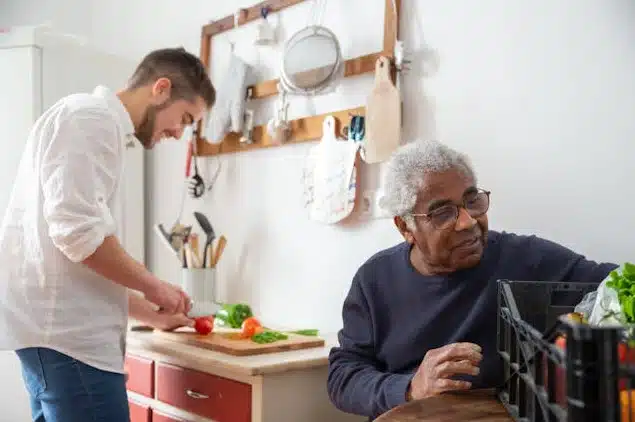Malnutrition in Older Adults: Signs and Solutions
Posted in Senior Health Care Tips
Maintaining a healthy diet is a key component of long-term health and promotes a strong immune system, muscle mass to aid in fall prevention, and supports long-term cognitive health.
Unfortunately, an increasing number of older adults are at risk of malnutrition. A 2022 survey conducted by the nonprofit Feeding America found that nearly 1 in 11 older adults face food insecurity.
While malnutrition poses a significant hazard for older adults, strategies to intervene exist and there are countless organizations that can provide assistance. The biggest challenge in combating malnutrition among older adults is actually identifying those who need help.
Here on the warning signs of malnutrition, its effects on older adults, and how you can help.
Signs of Malnutrition
A poor diet can have significant impacts on an older adult’s health, however these warning signs are all too often missed by friends and family members because they can appear to be normal symptoms of the aging process. These symptoms include:
- Significant weight loss
- Clothes appearing baggier or oversized
- Muscle weakness
- Irregular meal pattern or inability to remember when they last ate
- Lack of energy
- Slow healing bruises and/or dry, cracked skin
- Frequent illness and slow recovery
- Presence of expired food in the home or lack of food
- Poor memory
You will notice that many of these warning signs can take some time to develop and can appear quite subjective to individuals without medical training. If you are concerned a loved one may be experiencing malnutrition, talking is key.
Take time to ask your loved one about their eating schedule and/or how frequently they go shopping for groceries. If the above warning signs are present and your loved one has shaky answers to these questions, they may need help. 
Causes and Risk Factors for Malnutrition
An inability to prepare meals, shop for groceries, or eat without discomfort are common causes for malnutrition in older adults. These obstacles are often caused by the following challenges:
- Social isolation: Eating meals is a common social activity. Living alone or losing contact with friends and family can cause a loss of interest in eating or cooking.
- Limited income: Limited financial resources due to costs of medical care and medication can make an older adult uncomfortable spending money on food.
- Inability to eat: Difficulty chewing, swallowing, using utensils, or poor dental health can make the act of eating difficult or painful.
- Inability to prepare meals: Limited manual dexterity, fear of household accidents, difficult-to-reach shelves, and fall hazards can make the process of preparing a meal extremely difficult.
- Depression: Depression can have a significant impact on appetite.
- Medication: Some medicines can lower a senior’s appetite or sensitivity to hunger or thirst.
- Loss of taste: Our sense of taste and smell grow weaker over time, and can eliminate the enjoyment of eating meals.
- Dementia and memory loss: Cognitive impairment due to dementia or Alzheimer’s can make it difficult to remember meal time, going grocery shopping, or safely cooking.
Working with a Physician
No one wants a loved one to suffer, but keeping the responsibility of managing malnutrition “in the family” by assisting with meal preparation and shopping can deprive your loved one of long-term, systematic solutions potentially available through their primary care physician, these include:
- Working with a dietician to determine the proper amount of calories and nutrition needed daily.
- Reviewing medication and looking for alternate prescriptions that can avoid impacting appetite.
- Treating underlying illnesses contributing to malnutrition.
- Using behavioral specialists to address psychological causes for malnutrition.
How to Help as a Family Member
Working with your loved one’s physician is a key step towards preventing malnutrition, however there are additional steps you can take as a family member to ensure your loved one remains healthy. These include:
- Assisting in grocery shopping and/or meal preparation.
- Reconfiguring your loved one’s kitchen to make meal preparation easier.
- Replacing utensils and kitchen appliances with models designed for use by people with limited manual dexterity.
- Setting up food and grocery delivery services.
- Reaching out to support networks like your local Meals on Wheels chapter.
- Hiring an in-home caregiver to support your loved one.
Malnutrition is a common challenge for older adults, but it can be overcome with early detection, planning and ongoing support.
When an older adult begins to show signs of malnutrition, many families make the decision to bring home health caregivers into their loved one’s home. A home health caregiver can assist with grocery shopping, meal planning, cooking, and assist clients who have difficulty eating alone. Home caregivers also provide valuable companionship to make meals happier events and can provide ongoing supervision, ensuring an older adult’s family and doctors are rapidly notified in the event of any changes in eating habits.
If you are concerned about a loved one’s nutritional health, or if you struggle to eat like you once did and wish you had another helping hand in your life, call us today. Our team of home health care experts have helped New Yorkers live happier, healthier lives in their long-time homes for 40 years.
To learn more about how SelectCare helps, call SelectCare today, request a free in-home care guide, or read firsthand client experiences on our testimonial page.
